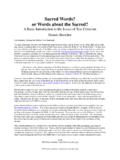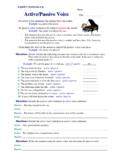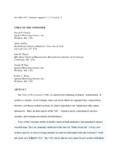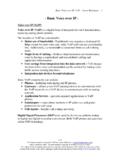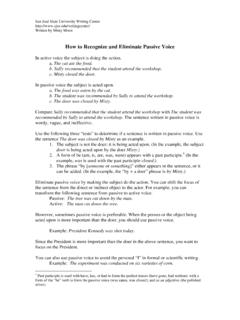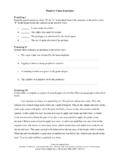Transcription of The Gospels and the Synoptic Problem
1 The Gospels and the Synoptic Problem The Literary Relationship of Matthew, Mark, and Luke Dennis Bratcher Introduction The Synoptic Problem is not really a Problem in the normal sense of the term. It is simply a way to refer to questions and possible explanations about the literary relationships between the first three New Testament Gospels . The word Synoptic means with the same eye or seeing together. Matthew, Mark, and Luke present the basic story of Jesus in similar ways, including the order of the material, the stories told, the sayings of Jesus, even using many of the same words in parallel accounts. For this reason they are called the Synoptic Gospels . On the other hand, while the gospel of John sometimes resembles the other three Gospels , it tells the story of Jesus in significantly different ways, including a different order of events, different perspectives and points of emphasis, and with its own unique vocabulary and style. Those differences can be understood in terms other than literary relationships between the Gospels , which is the reason John is not included in the Synoptic Problem .
2 To someone who has never studied the Gospels closely, or who has assumed certain logically constructed theories about the nature of Scripture apart from looking at the actual biblical text ( , the absolute inerrancy of Scripture), questions about the literary relationship between the Gospels may be unnerving at first. It is easy simply to reject them as so much scholarly speculation and academic conjecture. Yet, these questions arise from the biblical text itself, questions obvious to most anyone who takes the time to examine the biblical text closely. If we are honestly to hear and understand Scripture on its own terms, we will have to come to terms with this issue in ways that go beyond simply denying that there is any issue because of a certain theology or ideology about Scripture. On the other hand, we need honestly to concede at the beginning that there is no final answer to this Problem . There are various perspectives, hypotheses, and theories based on the evidence of the biblical text as well as what we know about the process of writing.
3 But there is not a correct answer. That simply suggests that while we need to take this issue seriously as part of what we see in the biblical text as we have it, it is not a matter of faith one way or the other. Rather, it is simply being honest with the biblical text and not trying to make it say or be what it is not. It is also acknowledging that we do not have to have all of the answers to our logical questions before we can accept the Bible as Scripture for the Church. The issue is not a matter of believing or not believing the Bible; it is a matter of believing, and then seeking to understand as best we can that which we believe ( faith seeking understanding ). So, one might ask why we should bother with the issue at all if there is no correct solution to a Problem . that is not an essential matter of Christian Faith. Here we return to a simple principle that grew out of the Protestant reformation, the principle of sola scriptura, only Scripture. This principle, as one of the cornerstones of the Reformation, held that Scripture should be the first and final authority for the faith and practice of the Church, and that it should be allowed to stand in judgement over all human creeds, doctrines, and traditions.
4 As that principle worked out in the history of the church in the centuries following the Reformation, it meant a rigorous honesty with how Scripture was studied. The goal was to hear the Bible as Scripture for the church, neither in isolation from the traditions of the Faith nor captive to them. This allowed the development of critical methodologies for the investigation of Scripture that included a careful and detailed reading of the biblical texts for what they actually said apart from the doctrines that told people what they should mean. This did not deny the authority of the Bible as the inspired word of God. In fact, it affirmed it Copyright 2005, Dennis Bratcher, All Rights Reserved CRI/Voice, Institute 2. even more strongly. But it did allow the biblical text to be seen as something more than a repository of timeless and unchanging truths written by the finger of God. While not always as successful in objectivity as envisioned, these critical methods allowed the tremendous diversity of the biblical text to emerge, a diversity that had been masked for many centuries by dogmatic and doctrinal approaches that sought to harmonize any differences in the biblical text.
5 The rich texture of the biblical traditions emerged as the witness of various communities of faith over many centuries to God's self-revelation in their history came to light (see Revelation and Inspiration of Scripture). Like an elegant tapestry, the Bible could be viewed on a broad scale as a marvelous record of God's dealing with humanity, the story of God in striking panorama. Yet, on closer inspection, the tremendous complexity of the fabric and the threads that created the larger picture could now be seen. Biblical study then turned to the careful examination of these strands as a way to help understand the larger picture. So, an understanding of the Synoptic Problem is a crucial first step in any detailed study of the Gospels and their testimony to Jesus the Christ, simply because it allows us to begin with the witness of the biblical text itself. That will not assure a student of the New Testament that everything s/he concludes will be unbiased and objective.
6 But it will encourage us to listen to the text, to take it seriously even in all its diversity, and will constantly warn us against a too easy and perhaps unconscious manipulation of Scripture for any particular theological agenda. The Problem . The Synoptic Gospels share a great deal of material and features. There are differences between them in many areas, some more pronounced than others. Yet, all the questions about the differences arise precisely because of the otherwise close parallels between the Synoptics. While we might be able to answer some of these questions about differences as a matter of context, culture, personality, or purpose, the parallels are not as easily explained. The questions that arise about the literary relationships between the Synoptic Gospels concern both the differences as well as the similarities, although the similarities really focus the questions. So, the Synoptic Problem is the way that serious students of the Gospels attempt to understand the origins and interrelationships of the first three Gospels that will explain both the similarities and the differences between them.
7 There are places where the Synoptic Gospels are closely parallel in their recounting of incidents from the life of Jesus. For example, in the account of the calling of Levi (Matthew): Matthew (9:9-13) Mark (2:13-17) Luke (5:27-32). 13 Jesus went out again beside the sea; the 27 After this he went out whole crowd gathered around him, and he taught them. 9 As Jesus was walking along, 14 As he was walking along, he saw a man called Matthew sitting at the tax he saw Levi son of Alphaeus sitting at the tax and saw a tax collector named Levi, sitting at booth; and he said to him, Follow me. And booth, and he said to him, Follow me. And the tax booth; and he said to him, Follow he got up and followed him. he got up and followed him. me. 28 And he got up, left everything, and followed him. 10 And as he sat at dinner in the house, many 15 And as he sat at dinner in Levi's house, 29 Then Levi gave a great banquet for him in tax collectors and sinners came and were many tax collectors and sinners were also his house; and there was a large crowd of tax sitting with him and his disciples.
8 Sitting with Jesus and his disciples--for there collectors and others sitting at the table with were many who followed him. them. 11 When the Pharisees saw this, 16 When the scribes of the Pharisees saw that 30 The Pharisees and their scribes he was eating with sinners and tax collectors, they said to his disciples, Why does your they said to his disciples, Why does he eat were complaining to his disciples, saying, teacher eat with tax collectors and sinners? with tax collectors and sinners? Why do you eat and drink with tax collectors and sinners? . 12 But when he heard this, 17 When Jesus heard this, he said, Those who are well have no need of a he said to them, Those who are well have no 31 Jesus answered, Those who are well have physician, but those who are sick. need of a physician, but those who are sick; no need of a physician, but those who are sick;. 13 Go and learn what this means, I desire mercy, not sacrifice.'. Copyright 2005, Dennis Bratcher, All Rights Reserved CRI/Voice, Institute 3.
9 For I have come to call not the righteous but I have come to call not the righteous but 32 I have come to call not the righteous but sinners. sinners. sinners to repentance. How can we explain these very close parallels between the Synoptic Gospels , especially considering that the Gospels were likely written in different places at different times? Were they using a common written source or a shared tradition in their writing? Did there exist a record of Jesus that was earlier than the Gospels that all the writers used in producing their own gospel ? If so, why were the Gospels themselves written if there already existed an earlier account? If either written sources or oral tradition were used in the compilation of the Gospels , were those sources reliable? Would the sources have to be inspired in order for the Gospels to be inspired? And exactly how were the sources used? Were the gospel writers simply trying faithfully to reproduce those sources? Or did the gospel writers feel free to interpret and apply the Jesus traditions as they wrote their Gospels ?
10 These are the questions that lie at the heart of the Synoptic Problem . Yet, as similar as they are, there are still differences between the Gospels on many levels. Even in these very similar passages, there are minor differences of word order, words used, syntax and style of writing, and grammatical variations. There are also differences in other details between the Gospels , some of which can be seen above. Sometimes names are included or omitted, or are given in different forms, as in the illustration above where Matthew is called Levi in Mark and Luke. Sometimes additional details are added in one account, such as the quotation from Hosea added in Matthew's version above (v. 13). Sometimes a saying of Jesus is recorded in Aramaic, while the parallel passages record it in Hebrew, for example in Jesus' quotation of Psalm 22:1 from the cross, recorded in Aramaic in Mark (15:34) but in Hebrew in Matthew (27:46). Sometimes different but synonymous Greek words are used in an otherwise parallel passage.
